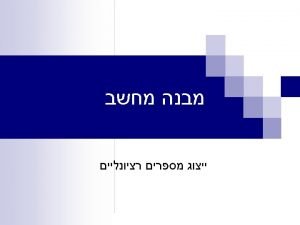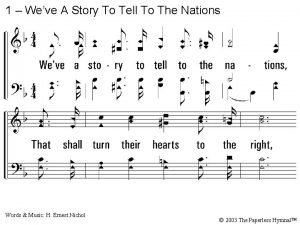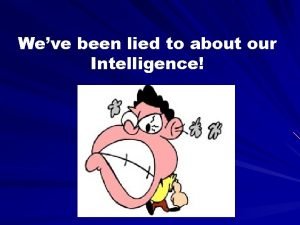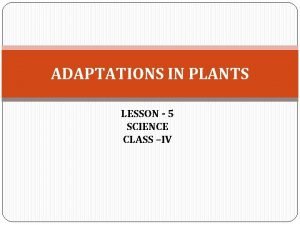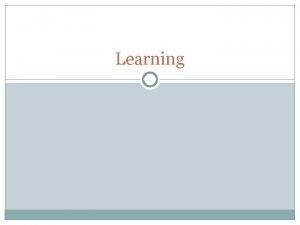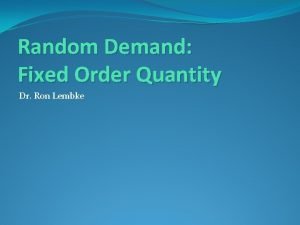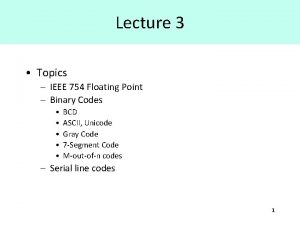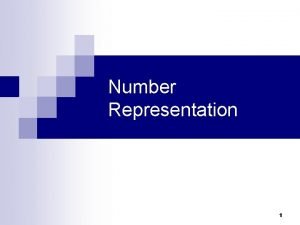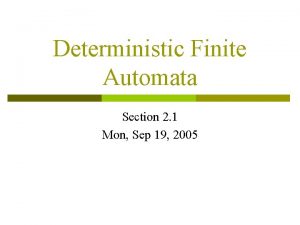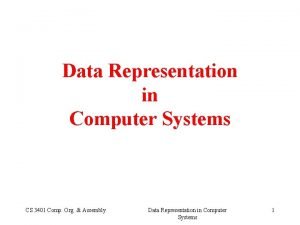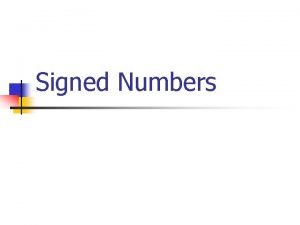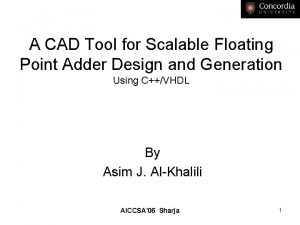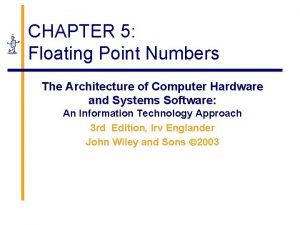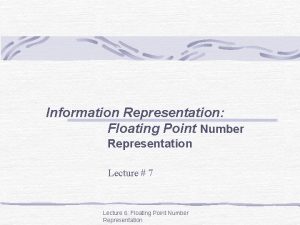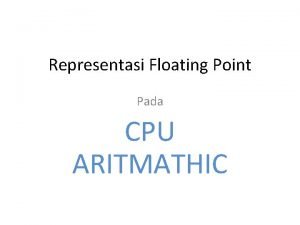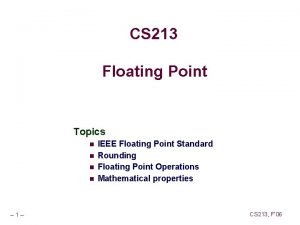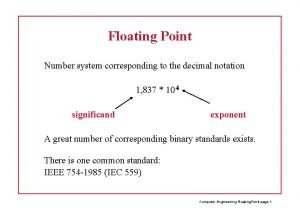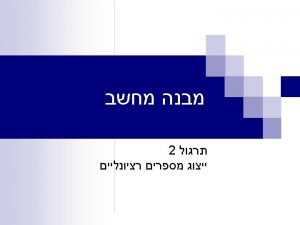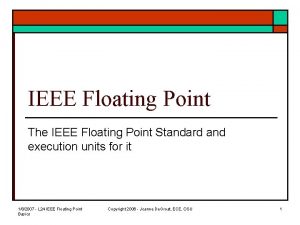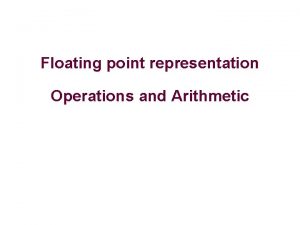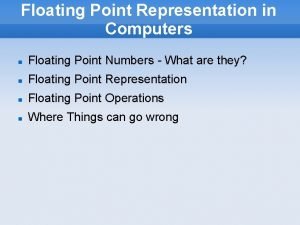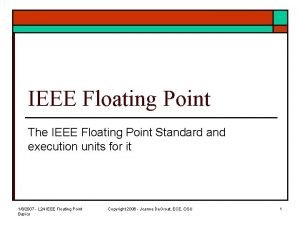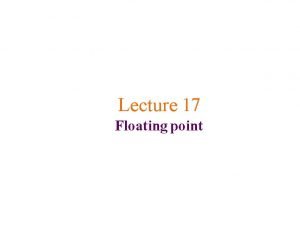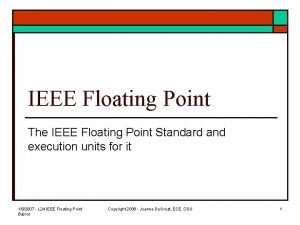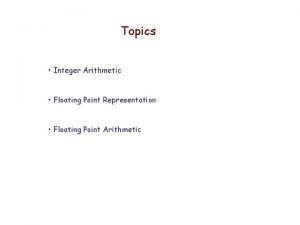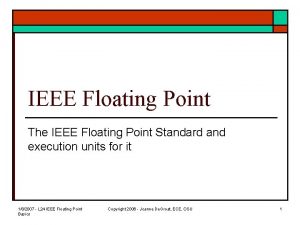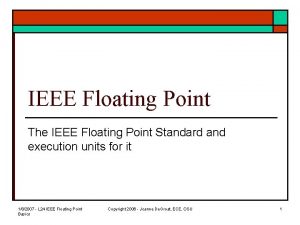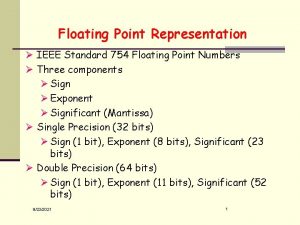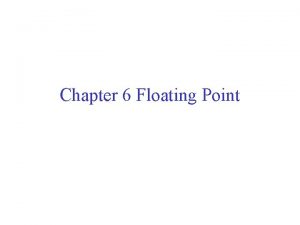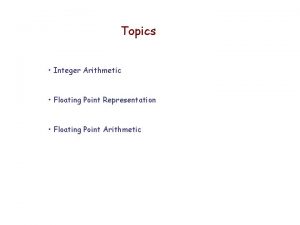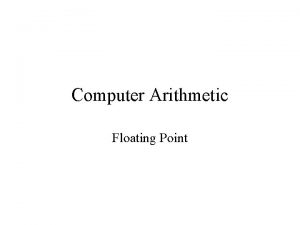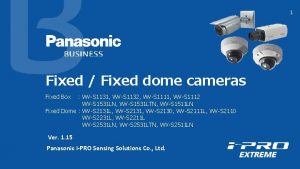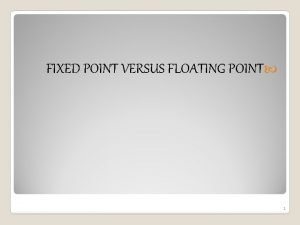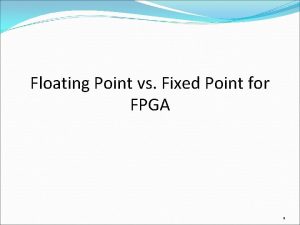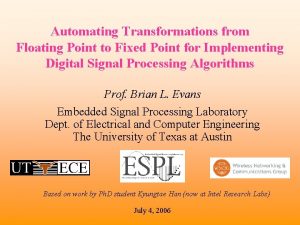Fixed Point vs Floating Point n n Weve























- Slides: 23


Fixed Point vs. Floating Point n n We’ve already seen two ways to represent a positive integer in computer hardware: signed and unsigned. Both ways were with a fixed point representation - the location of the binary point was fixed: 0 1 1 1 0 1 נועם חזון , תמר שרוט

Floating Point n n Going back to decimal… Sometimes it is more comfortable to represent a value using a floating point. ¨ For instance: Exponent Mantissa n Generally, we use the form נועם חזון , תמר שרוט Base

Floating Point n If we look at 123: ¨ n The same goes for (fixed point) 123. 456: ¨ נועם חזון , תמר שרוט

Floating Point n Using the form: ¨ ¨ נועם חזון , תמר שרוט

Binary Rationals n Converting from any base to decimal is done as before. ¨ So, for instance, the binary number 100. 101: נועם חזון , תמר שרוט

Binary Rationals n For converting from decimal to binary, we’ll use a polynomial of base 2: ¨ So, n for instance 20. 75 to binary: What about converting to floating point? נועם חזון , תמר שרוט

Binary Rationals n n Here, of course In order to transform the result to floating point, we’ll continue from here: נועם חזון , תמר שרוט

Binary Rationals n Problem: how can we convert simple fractions to binary? Binary representation might require infinite number of digits. ¨ For example: ¨ We have an algorithm. נועם חזון , תמר שרוט

Algorithm for Simple Fractions n n write “ 0. ” while (true) do: ¨ If n Break ¨ else n n If ¨ write “ 1” ¨ n else write “ 0” נועם חזון , תמר שרוט

Algorithm for Simple Fractions n For instance: ¨ 0. 010 n And so on… ¨ 0. 0101… נועם חזון , תמר שרוט

Algorithm for Simple Fractions n From here, converting to floating point is easy: נועם חזון , תמר שרוט

Binary Rationals n Problems: ¨ This algorithms can run to infinity. ¨ Furthermore, we do not have an endless supply of digits. n Solution: ¨ Run the main loop the number of times as the number of digits you have for the fraction part. נועם חזון , תמר שרוט

Fixed Algorithm for Simple Fractions n n write “ 0. ” for each available digit to fraction part do: ¨ If n Break ¨ else n n If ¨ write “ 1” ¨ n else write “ 0” נועם חזון , תמר שרוט

Mixed Part Numbers n For mixed whole and simple fraction parts numbers, like : ¨ Convert the integer part to binary as we learned on integers. ¨ Convert the fraction part as learned now. ¨ Add the results. ¨ Only now, if desired, convert to floating point. נועם חזון , תמר שרוט

Float vs. Double n n n So how many digits do we really have? Depends on the representation. We have two possible representations for floating point values: 4 -byte float and 8 -byte double. It all depends on the amount of accuracy we need. נועם חזון , תמר שרוט

Hidden Bit n As mentioned before, we use the form: n Where In decimal, every digit would have values in the range 0. . 9 besides which have values in range 1. . 9. Likewise, in binary, could only have the value of 1. So why should we save it? Since we won’t save it, we’ll refer to it as the “hidden bit” n n נועם חזון , תמר שרוט

Float 31 30 23 22 sign exponent+127 1 bit n n 0 mantissa 8 bits 23 bits 32 -bit (4 -byte) representation. 1 bit for sign: 1 for negative, 0 for positive. 23 bits for mantissa. 8 bits for the exponent. Important: The true value of a exponent is unsigned exponent representation - 127. נועם חזון , תמר שרוט

Float Limitations 31 30 23 22 sign exponent+127 1 bit n n 0 mantissa 8 bits 23 bits 0 is represented with mantissa=0 and “computer” exponent=0. Max absolute value (all 1’s in mantissa and 11111110 exponent): n Min absolute value (0 in mantissa and 1 as “computer” exponent): n “Computer” exponent=0 and mantissa different from 0 represent sub-normal numbers “Computer” exponent=255 represent and Nan. n נועם חזון , תמר שרוט

Double 63 62 52 51 sign exponent+1023 1 bit n n 0 mantissa 11 bits 52 bits 64 -bit (8 -byte) representation. 1 bit for sign: 1 for negative, 0 for positive. 52 bits for mantissa. 11 bits for the exponent. Important: The true value of a exponent is unsigned exponent representation - 1023. נועם חזון , תמר שרוט

Double Limitations 63 62 52 51 sign exponent+1023 1 bit n n n 0 mantissa 11 bits 52 bits 0 is represented with mantissa=0 and “computer” exponent=0. Max absolute value (all 1’s in mantissa and 111110 exponent): Min absolute value (0 in mantissa and 1 as “computer” exponent): “Computer” exponent=0 and mantissa different from 0 represent sub-normal numbers “Computer” exponent=2047 represent and Nan. נועם חזון , תמר שרוט

Examples (1) 31 1 30 10000110 1 bit n 23 22 0 101000000000 8 bits 23 bits Convert the following float to decimal: ¨ ¨ ¨ 0 xc 3528000 = 1100 0011 0101 0010 1000 0000 As float parts: 1 10000110 101000000000 With hidden bit: (1. )10100101 As decimal: 134 Real exp. : 7 Sum up: נועם חזון , תמר שרוט

Examples (2) 31 0 30 0 10000010 1 bit n 23 22 100000000000 8 bits 23 bits Convert 12. 125 to float: ¨ ¨ ¨ As polynomial: Factor out: As parts: Represented as: Binary exp. : + 3 0 130 0 10000010 נועם חזון , תמר שרוט (1. )1000010… 0
 Fixed point representation
Fixed point representation We've a story to tell to the nations
We've a story to tell to the nations Weve been lied to
Weve been lied to Weve got the beat
Weve got the beat What is virtual ram
What is virtual ram Weve got this
Weve got this Adaptation in plants for class 4
Adaptation in plants for class 4 Fixed interval vs fixed ratio
Fixed interval vs fixed ratio Fixed order quantity vs fixed time period
Fixed order quantity vs fixed time period Fixed interval reinforcement
Fixed interval reinforcement Fixed function ic package
Fixed function ic package Fixed interval vs fixed ratio
Fixed interval vs fixed ratio Ieee 754 floating point
Ieee 754 floating point Floating point arithmetic examples
Floating point arithmetic examples Dfa for floating point numbers
Dfa for floating point numbers Express (32)10 in the revised 14-bit floating-point model
Express (32)10 in the revised 14-bit floating-point model Floating point representation
Floating point representation Range of signed numbers
Range of signed numbers Floating point adder vhdl
Floating point adder vhdl Parts of a floating point number
Parts of a floating point number Why use floating point numbers
Why use floating point numbers Floating point representation adalah
Floating point representation adalah Floating point puzzles
Floating point puzzles Floating-point number
Floating-point number
